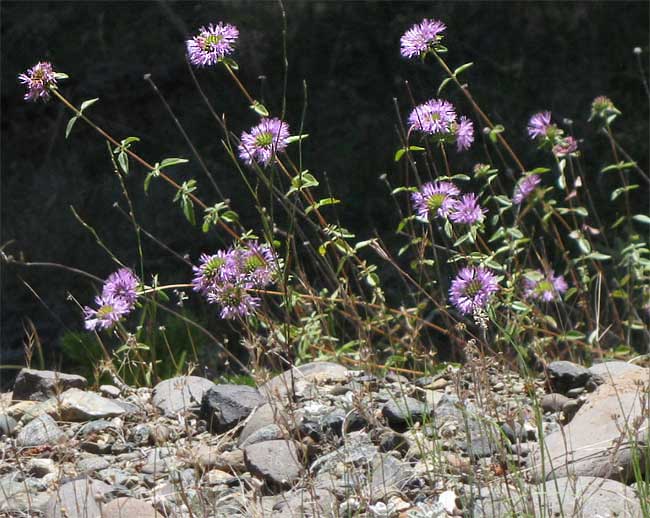Excerpts from Jim Conrad's
Naturalist Newsletter

from the the July 19, 2009 Newsletter, issued from the Siskiyou Mountains west of Grants Pass, Oregon:
COYOTE MINT
For a couple of weeks one of the most eye-catching wildflowers at woods edges and along backcountry roads has been the woody-based, bee-attracting plant shown above.
With its opposite leaves and dense, spherical flower head subtended by a collar of modified leaves, or bracts, you don't have to pinch one of its leaves to smell its pungent, minty odor to know that the plant belongs to the Mint Family. Sometimes you see hundreds growing like weeds along roads so I figured it must be a wide-ranging weed, and I felt a bit ashamed for not recognizing it.
It keyed out to the genus Monardilla, 28 species of which are listed in California's Jepson Manual. No Monardilla is mentioned in Weakley's Flora of the Carolinas, so this is another of those western genera Easterners just don't hear about. The plants further keyed out to MONARDILLA SHELTONII, which turns out to be endemic to just three southwestern Oregon counties and a bit of northern California. You can see some of the features distinguishing Monardilla sheltonii below:

There I've broken a flowering head in two and hold a single flower with its four stamens at the tip of my thumb. The species is very close to M. villosa, but its calyxes are not glandular-hairy, and its leaf undersides are not wooly.
In figuring out this species I was helped by the online "Google Books" site where I found Plants of Western Oregon, Wshington & British Columbia by Eugene Kozloff. This is a wonderful resource -- if you have a fast internet connection, which I don't. To find the book online, Google the title and "Google Books."
What a pleasure to find an endemic like this unlike anything I've ever seen before -- especially when there are whole roadsides of them growing like weeds!